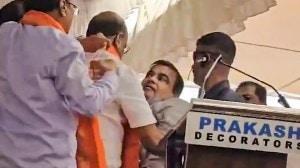- India
- International
The Birth of Kumara and Other Stories
Translations of a play and a mahakavya make Kalidasa accessible to a generation more familiar with English.
 Kumarasambhavam is about Shiva Parvati and their son. (Source: Thinkstock)
Kumarasambhavam is about Shiva Parvati and their son. (Source: Thinkstock)
Bibek Debroy
Book: Kumarasambhavam
Author: Kalidasa, translated by Hank Heifetz
Publisher: Penguin Books
Pages: 240
Price: Rs 399
The rich tapestry of classical Sanskrit literature has many poets and playwrights — Shudraka, Bhasa, Ashvaghosa, Bharavi, Magha, Shriharsha, Banabhatta, Dandin. Everyone has a favourite. Mine, and that of several other people, is Kalidasa. We know precious little about Kalidasa. We can’t even date him satisfactorily, though 4th or 5th century is reasonable. We know little about his life, much that floats around is legend. Indeed, we don’t even have a proper list of what he wrote, since many works purportedly written by Kalidasa weren’t his composition. However, six or seven is probably right — three plays (Abhijnanashakuntalam, Vikramorvashiyam, Malavikagnimitram), two mahakavyas (Kumarasambhavam, Raghuvamsha) and two khandakavyas (Meghadutam, Ritusamhara). There is a specific genre, with specific characteristics, for a work to be classified as mahakavya. If one leaves out the two epics, there are only five that conform to the template (we needn’t get into the details of the template). Two are by Kalidasa — Bharavi, Magha and Shriharsha accounting for one each. A khandakavya is simply a minor (but longish) poetical work. There is a famous Sanskrit shloka that says the great thing about Kalidasa was his use of similes.
Sanskrit is a language that flows seamlessly, like water. Words are combined with other words, through grammatical rules. Classical Sanskrit poetry isn’t about rhyming. That came much later. Nor is the place a subject/verb/object occupies in a sentence important. That fluidity was combined with a very tight metrical structure, the domain of chhanda or prosody. Depending on the count of syllables in a sentence (and their distribution), there is a listing of almost 200 different metres. A poet was good, bad or indifferent, depending on how ingenious he/she was within the given metrical structure. Not that plays were poetry. Kavyas (maha or khanda) had to be poetry. But plays mixed both and plays (depending on characters) were often laced with Prakrit too, not just Sanskrit. Compared to the interest about Kalidasa, there aren’t too many translations, at least not in English. Meghadutam is the odd one out, where several people have taken a shot. One can understand why. Translating poetry is difficult, the translator has to be a bit of a poet to do that, and trans-creation isn’t the same as translation. How does one capture similes? If one can do that, how does one capture the metre? It isn’t that translations are non-existent. But they are old and archaic and they aren’t very good at capturing the poetry. They are a bit like word-for-word literal translations.
We now have two of Kalidasa’s works published together, in companion volumes — Kumarasambhavam, translated by Hank Heifetz and Malavikagnimitram, translated by Srinivas Reddy. Of these, Heifetz is a reprint, the first edition was published in 1990. There is no substitute to reading the originals in Sanskrit, though. But since that isn’t an option available to everyone, translations are necessary, especially to a generation more familiar with English. Of the two, Reddy had the easier task, since Malavikagnimitram is partly in prose and the poetry bits are simpler. The story of Malavikagnimitram is perhaps less familiar. King Agnimitra falls in love with a dancer named Malavika. Kumarasambhavam is, of course, the more familiar story of Sati being reborn as Parvati, performing tapasya and marrying Shiva, leading to the birth of Kumara (Skanda), who delivers the gods from the demon Taraka. How many sargas (cantos) does Kumarasambhavam have? This is an important question, because there are manuscripts with 17 sargas. But some of these sargas are by later poets and inferior. Scholars agree only the first eight sargas are by Kalidasa himself. However, in many Indian translations (including in the vernacular), the eighth sarga is missing. It is about Shiva and Parvati’s love-making and is sometimes excised. Heifetz does have it.
If you compare Heifetz with something like the Arthur Ryder translation, Heifetz is vastly superior (in any event, Ryder isn’t complete). If you compare Reddy with the Clay Sanskrit Library translation, I am less sure. Reddy does a competent job and as I said, the task was easier compared to Heifetz. Where Heifetz scores is in the quality of end-notes, which bring out the quality of the metre far better. There are a few instances where I have wondered about the Heifetz choice of words. Gavaya is the “gayal” or “mithun”. Why call it a “Garhwal bull” (1.56)? Why should digvarana (elephants who guard the directions) become “elephants of the air” (2.44)? Did pinakina (the one who wields the Pinaka bow) have to become “Lord of the Sheltering Bow” (5.77)? Kriyanam khalu dharmyanam as “ritual life” (6.13) jars. There is also a typo in karinikara (3.28). It should be karnikara. But compared to the stupendous and impressive effort, these are trivia. If you want to get a flavor of Kalidasa in English, do read Ryder. I am more hesitant about Reddy.

Bibek Debroy is an economist and a translator of the Mahabharata
Apr 24: Latest News
- 01
- 02
- 03
- 04
- 05







































